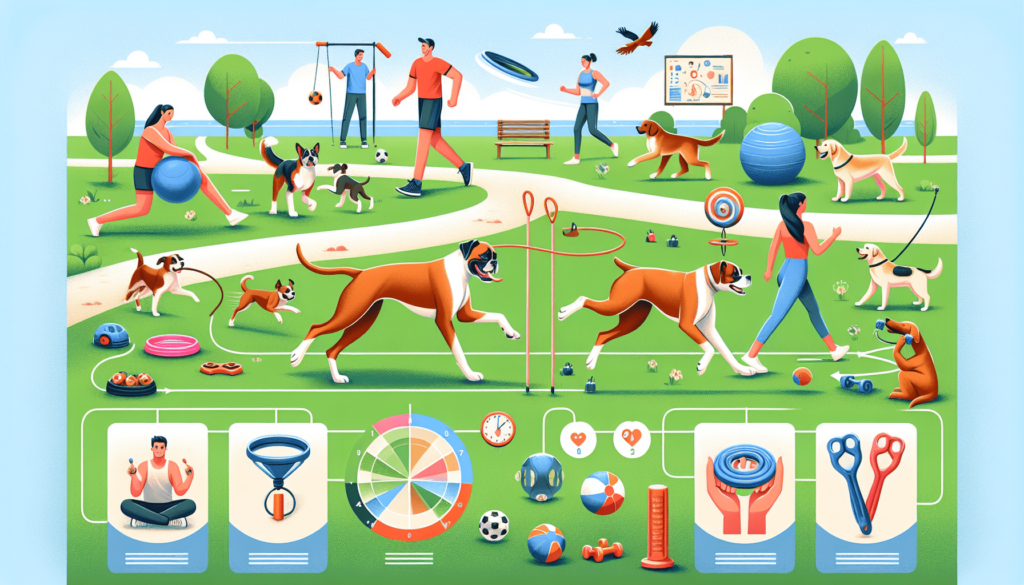Have you ever wondered if your furry friend is getting enough exercise? It can be a challenge to ensure that your dog is getting the right amount of physical activity to keep them happy and healthy. In this article, we will explore the importance of creating a balanced exercise plan for your dog and provide practical tips on how to do so. From determining your dog’s specific exercise needs to incorporating a variety of activities, you’ll be equipped with all the information you need to create a routine that will keep your dog active and engaged. So, let’s get started on creating a balanced exercise plan that will have your pup wagging their tail with delight!

Setting Goals
When it comes to creating an exercise plan for your dog, setting goals is an important first step. Understanding your dog’s breed and age is crucial in determining the appropriate level and type of exercise they need. Different breeds have different energy levels and exercise requirements, so it’s essential to tailor the plan to your dog’s specific needs. Consulting with a veterinarian can provide valuable insights and guidance in setting realistic goals for your furry friend. By considering your dog’s individual needs, you can ensure that the exercise plan is both effective and enjoyable for them.
Choosing the Right Activities
Designing a variety of activities is key to keeping your dog engaged and interested in their exercise routine. Dogs, like humans, can get bored with repetitive exercises. Incorporating cardiovascular exercises, such as brisk walks, jogging, or playing fetch, helps keep their heart healthy and their weight in check. Additionally, including strength and endurance exercises, such as agility training or hiking, can help build their muscles and improve their overall fitness level. By mixing up the activities, you ensure that your dog gets a well-rounded workout while having fun.
Planning Exercise Duration
Determining the appropriate exercise duration for your dog is crucial to avoid overexertion or inadequate physical activity. Factors such as breed, age, and energy levels should be considered when determining how long to exercise your dog. Puppies and senior dogs, for example, may require shorter exercise sessions compared to young adult dogs. It’s important to listen to your dog’s cues and gradually increase the duration of their exercise as they build stamina. By finding the right balance, you can ensure that your dog gets enough physical activity without pushing them too hard.
Scheduling Exercise
Establishing a consistent exercise routine is beneficial for both you and your dog. Dogs thrive on routine and appreciate knowing what to expect. By having a set schedule for exercise, you can ensure that your dog gets the physical activity they need regularly. When scheduling exercise, it’s important to take into account your dog’s daily schedule and any commitments you may have. Finding the best time for exercise, whether it’s in the morning, afternoon, or evening, is essential to make it a seamless part of your dog’s day. Consistency and a well-planned schedule are key to a successful exercise plan.

Creating Mental Stimulation
Physical exercise is essential for dogs, but mental exercise is just as important. Including mental exercise in your dog’s exercise plan can keep their minds sharp and prevent boredom. Teaching them new tricks and commands not only engages their brain but also builds their bond with you. Using puzzle toys and interactive games, such as treat-dispensing toys or hide-and-seek, can provide mental stimulation while also satisfying their natural instincts. By incorporating mental exercises into their routine, you can create a well-rounded exercise plan that caters to their cognitive needs.
Socializing Opportunities
Dogs are social creatures, and providing opportunities for socialization is vital for their overall wellbeing. Organizing playdates with other dogs allows them to interact and learn appropriate social behaviors. Joining dog-friendly events or classes, such as obedience training or agility courses, not only provides mental and physical exercise but also exposes your dog to new environments and experiences. Visiting dog parks and trails is another way to give your dog the chance to interact with other dogs and enjoy off-leash play. By incorporating socialization into their exercise routine, you’re helping them develop good social skills and fostering a happy and well-adjusted dog.
Monitoring Exercise Intensity
While exercise is important, it’s crucial to monitor your dog’s exercise intensity to prevent exhaustion or overexertion. Dogs may not always know when to stop, and it’s up to you to recognize the signs of fatigue or discomfort. Heavy panting, excessive drooling, or reluctance to continue are all indications that your dog may be reaching their limit. Using heart rate monitors or activity trackers can provide valuable data on their exercise intensity and help you ensure that they’re not pushing themselves too hard. Additionally, regularly checking your dog’s body condition can help you track their fitness progress and adjust the exercise plan accordingly.
Providing Adequate Rest
Rest is just as important as exercise in maintaining a balanced exercise plan for your dog. Allowing for rest days in their routine gives their muscles time to recover and prevents overuse injuries. Providing comfortable resting areas, such as a cozy bed or a cool spot during hot weather, ensures that your dog can relax comfortably after exercise. Sufficient sleep and relaxation time contribute to their overall wellbeing and help them recharge for their next activity. By prioritizing adequate rest, you’re supporting your dog’s physical and mental health.
Hydration and Nutrition
Proper hydration before, during, and after exercise is crucial to keep your dog healthy and prevent dehydration. Always make sure your dog has access to fresh water, especially during hot weather or intense exercise sessions. Feeding a balanced diet that meets their nutritional needs is also vital for energy and muscle recovery. Consult with a veterinarian to determine the appropriate diet for your dog, considering their breed, age, and activity level. They can provide specific recommendations to ensure that your dog gets the nutrients they need to support their exercise routine.
Safety Measures
Keeping your dog safe during exercise should be a priority. Using appropriate exercise equipment, such as a well-fitting leash or harness, ensures that you have control over your dog and prevents accidents or injuries. Avoiding extreme weather conditions, such as exercising during extremely hot or cold temperatures, protects your dog from heatstroke or hypothermia. Additionally, it’s essential to be aware of potential hazards in exercise areas, such as toxic plants or busy roads. By taking necessary safety measures, you can create a secure environment for your dog to enjoy their exercise routine without unnecessary risks.
In conclusion, creating a balanced exercise plan for your dog involves setting clear goals, choosing the right activities, planning exercise duration, scheduling exercise, providing mental stimulation, incorporating socializing opportunities, monitoring exercise intensity, providing adequate rest, ensuring hydration and nutrition, and taking safety measures. By following these guidelines and tailoring the plan to your dog’s individual needs, you can provide them with a comprehensive exercise routine that promotes their overall health and happiness. Remember to always consult with a veterinarian for personalized advice and recommendations based on your dog’s specific circumstances. With a well-balanced exercise plan in place, you and your dog can enjoy the benefits of a healthy and active lifestyle together.

